Describe a data structure to represent sets of elements each
Solution
we can use Hashset for this.a simple code in hashset is given below
public class MyNode
{
...
}
public class MyDataStructure
{
private HashSet<MyNode> nodes = new HashSet<MyNode>();
/// <summary>
/// Inserts an element to this data structure.
/// If the element already exists, returns false.
/// Complexity is averaged O(1).
/// </summary>
public bool Add(MyNode node)
{
return node != null && this.nodes.Add(node);
}
/// <summary>
/// Removes a random element from the data structure.
/// Returns the element if an element was found.
/// Returns null if the data structure is empty.
/// Complexity is averaged O(1).
/// </summary>
public MyNode Pop()
{
// This loop can execute 1 or 0 times.
foreach (MyNode node in nodes)
{
this.nodes.Remove(node);
return node;
}
return null;
}
}
the unique key can also be achieved using dictioneries
hence code for this is given below:
public class FixedIntDictionary<T>
{
// Our internal node structure.
// We use structs instead of objects to not add pressure to the garbage collector.
// We mantains our own way to manage garbage through the use of a free list.
private struct Entry
{
// The key of the node
internal int Key;
// Next index in pEntries array.
// This field is both used in the free list, if node was removed
// or in the table, if node was inserted.
// -1 means null.
internal int Next;
// The value of the node.
internal T Value;
}
// The actual hash table. Contains indices to pEntries array.
// The hash table can be seen as an array of singlt linked list.
// We store indices to pEntries array instead of objects for performance
// and to avoid pressure to the garbage collector.
// An index -1 means null.
private int[] pBuckets;
// This array contains the memory for the nodes of the dictionary.
private Entry[] pEntries;
// This is the first node of a singly linked list of free nodes.
// This data structure is called the FreeList and we use it to
// reuse removed nodes instead of allocating new ones.
private int pFirstFreeEntry;
// Contains simply the number of items in this dictionary.
private int pCount;
// Contains the number of used entries (both in the dictionary or in the free list) in pEntries array.
// This field is going only to grow with insertions.
private int pEntriesCount;
///<summary>
/// Creates a new FixedIntDictionary.
/// tableBucketsCount should be a prime number
/// greater than the number of items that this
/// dictionary should store.
/// The performance of this hash table will be very bad
/// if you don\'t follow this rule!
/// </summary>
public FixedIntDictionary<T>(int tableBucketsCount)
{
// Our free list is initially empty.
this.pFirstFreeEntry = -1;
// Initializes the entries array with a minimal amount of items.
this.pEntries = new Entry[8];
// Allocate buckets and initialize every linked list as empty.
int[] buckets = new int[capacity];
for (int i = 0; i < buckets.Length; ++i)
buckets[i] = -1;
this.pBuckets = buckets;
}
///<summary>Gets the number of items in this dictionary. Complexity is O(1).</summary>
public int Count
{
get { return this.pCount; }
}
///<summary>
/// Adds a key value pair to the dictionary.
/// Complexity is averaged O(1).
/// Returns false if the key already exists.
/// </summary>
public bool Add(int key, T value)
{
// The hash table can be seen as an array of linked list.
// We find the right linked list using hash codes.
// Since the hash code of an integer is the integer itself, we have a perfect hash.
// After we get the hash code we need to remove the sign of it.
// To do that in a fast way we and it with 0x7FFFFFFF, that means, we remove the sign bit.
// Then we have to do the modulus of the found hash code with the size of our buckets array.
// For this reason the size of our bucket array should be a prime number,
// this because the more big is the prime number, the less is the chance to find an
// hash code that is divisible for that number. This reduces collisions.
// This implementation will not grow the buckets table when needed, this is the major
// problem with this implementation.
// Growing requires a little more code that i don\'t want to write now
// (we need a function that finds prime numbers, and it should be fast and we
// need to rehash everything using the new buckets array).
int bucketIndex = (key & 0x7FFFFFFF) % this.pBuckets.Length;
int bucket = this.pBuckets[bucketIndex];
// Now we iterate in the linked list of nodes.
// Since this is an hash table we hope these lists are very small.
// If the number of buckets is good and the hash function is good this will translate usually
// in a O(1) operation.
Entry[] entries = this.pEntries;
for (int current = entries[bucket]; current != -1; current = entries[current].Next)
{
if (entries[current].Key == key)
{
// Entry already exists.
return false;
}
}
// Ok, key not found, we can add the new key and value pair.
int entry = this.pFirstFreeEntry;
if (entry != -1)
{
// We found a deleted node in the free list.
// We can use that node without \"allocating\" another one.
this.pFirstFreeEntry = entries[entry].Next;
}
else
{
// Mhhh ok, the free list is empty, we need to allocate a new node.
// First we try to use an unused node from the array.
entry = this.pEntriesCount++;
if (entry >= this.pEntries)
{
// Mhhh ok, the entries array is full, we need to make it bigger.
// Here should go also the code for growing the bucket table, but i\'m not writing it here.
Array.Resize(ref this.pEntries, this.pEntriesCount * 2);
entries = this.pEntries;
}
}
// Ok now we can add our item.
// We just overwrite key and value in the struct stored in entries array.
entries[entry].Key = key;
entries[entry].Value = value;
// Now we add the entry in the right linked list of the table.
entries[entry].Next = this.pBuckets[bucketIndex];
this.pBuckets[bucketIndex] = entry;
// Increments total number of items.
++this.pCount;
return true;
}
/// <summary>
/// Gets a value that indicates wether the specified key exists or not in this table.
/// Complexity is averaged O(1).
/// </summary>
public bool Contains(int key)
{
// This translate in a simple linear search in the linked list for the right bucket.
// The operation, if array size is well balanced and hash function is good, will be almost O(1).
int bucket = this.pBuckets[(key & 0x7FFFFFFF) % this.pBuckets.Length];
Entry[] entries = this.pEntries;
for (int current = entries[bucket]; current != -1; current = entries[current].Next)
{
if (entries[current].Key == key)
{
return true;
}
}
return false;
}
/// <summary>
/// Removes the specified item from the dictionary.
/// Returns true if item was found and removed, false if item doesn\'t exists.
/// Complexity is averaged O(1).
/// </summary>
public bool Remove(int key)
{
// Removal translate in a simple contains and removal from a singly linked list.
// Quite simple.
int bucketIndex = (key & 0x7FFFFFFF) % this.pBuckets.Length;
int bucket = this.pBuckets[bucketIndex];
Entry[] entries = this.pEntries;
int next;
int prev = -1;
int current = entries[bucket];
while (current != -1)
{
next = entries[current].Next;
if (entries[current].Key == key)
{
// Found! Remove from linked list.
if (prev != -1)
entries[prev].Next = next;
else
this.pBuckets[bucketIndex] = next;
// We now add the removed node to the free list,
// so we can use it later if we add new elements.
entries[current].Next = this.pFirstFreeEntry;
this.pFirstFreeEntry = current;
// Decrements total number of items.
--this.pCount;
return true;
}
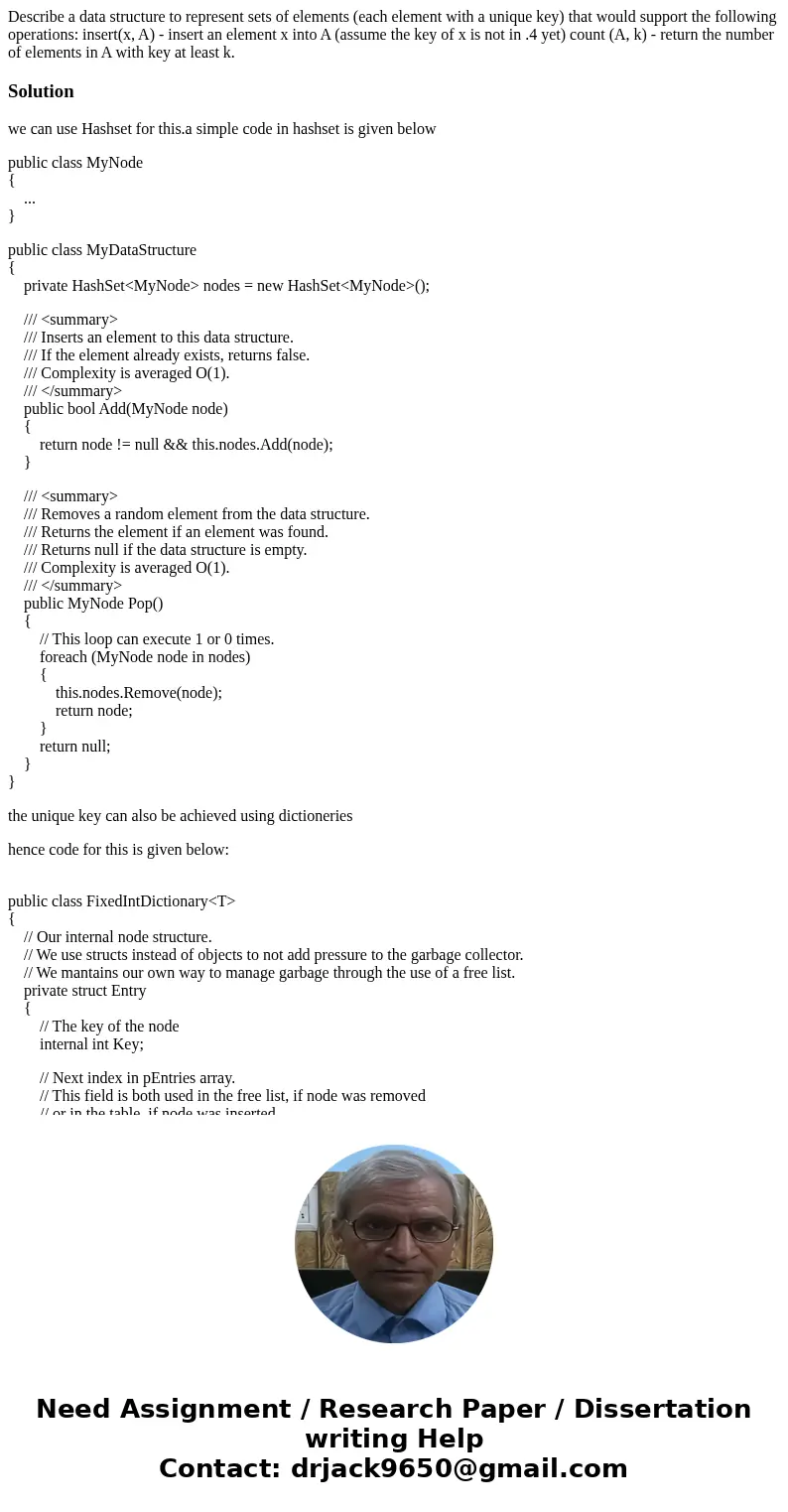
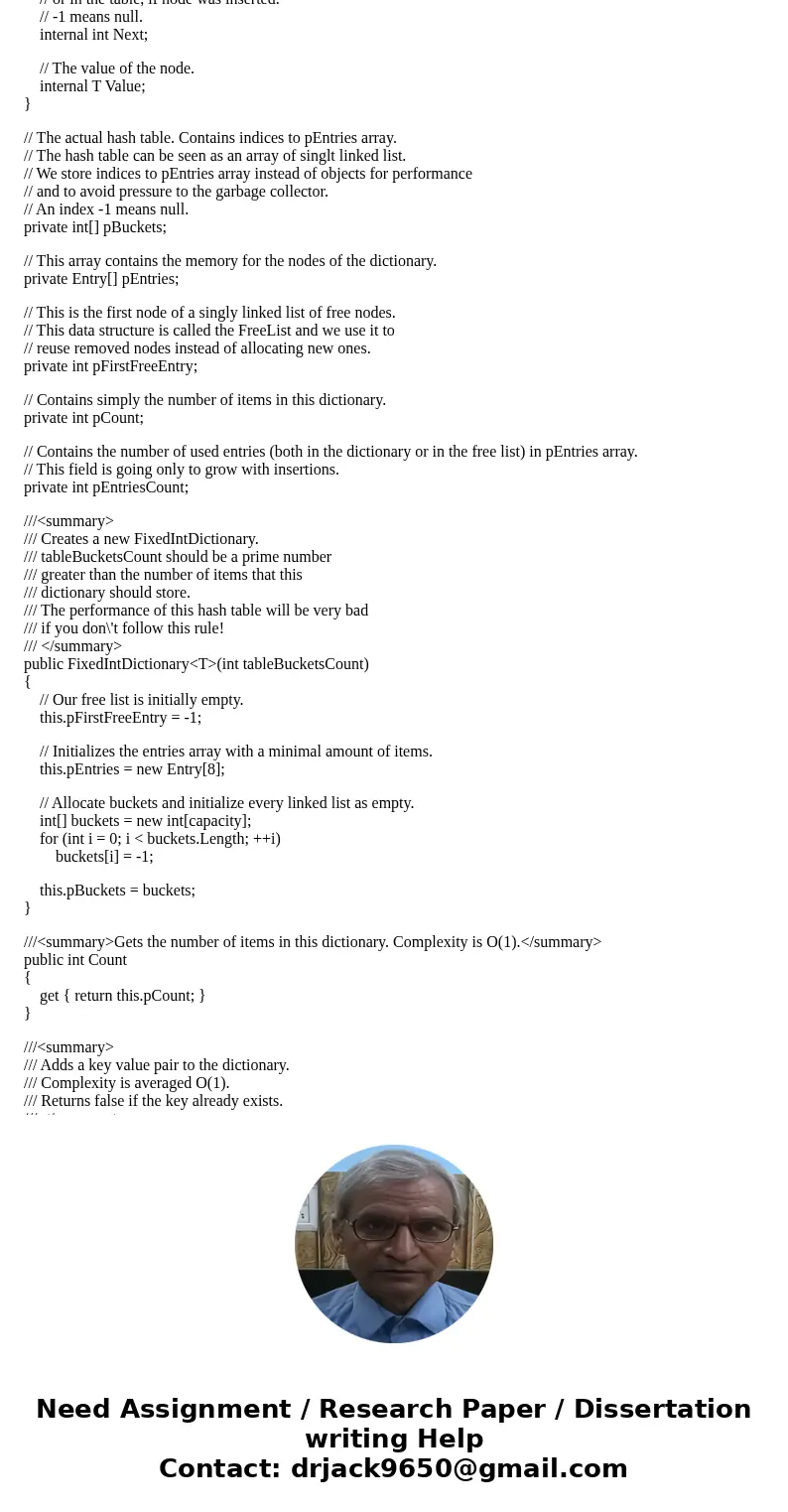
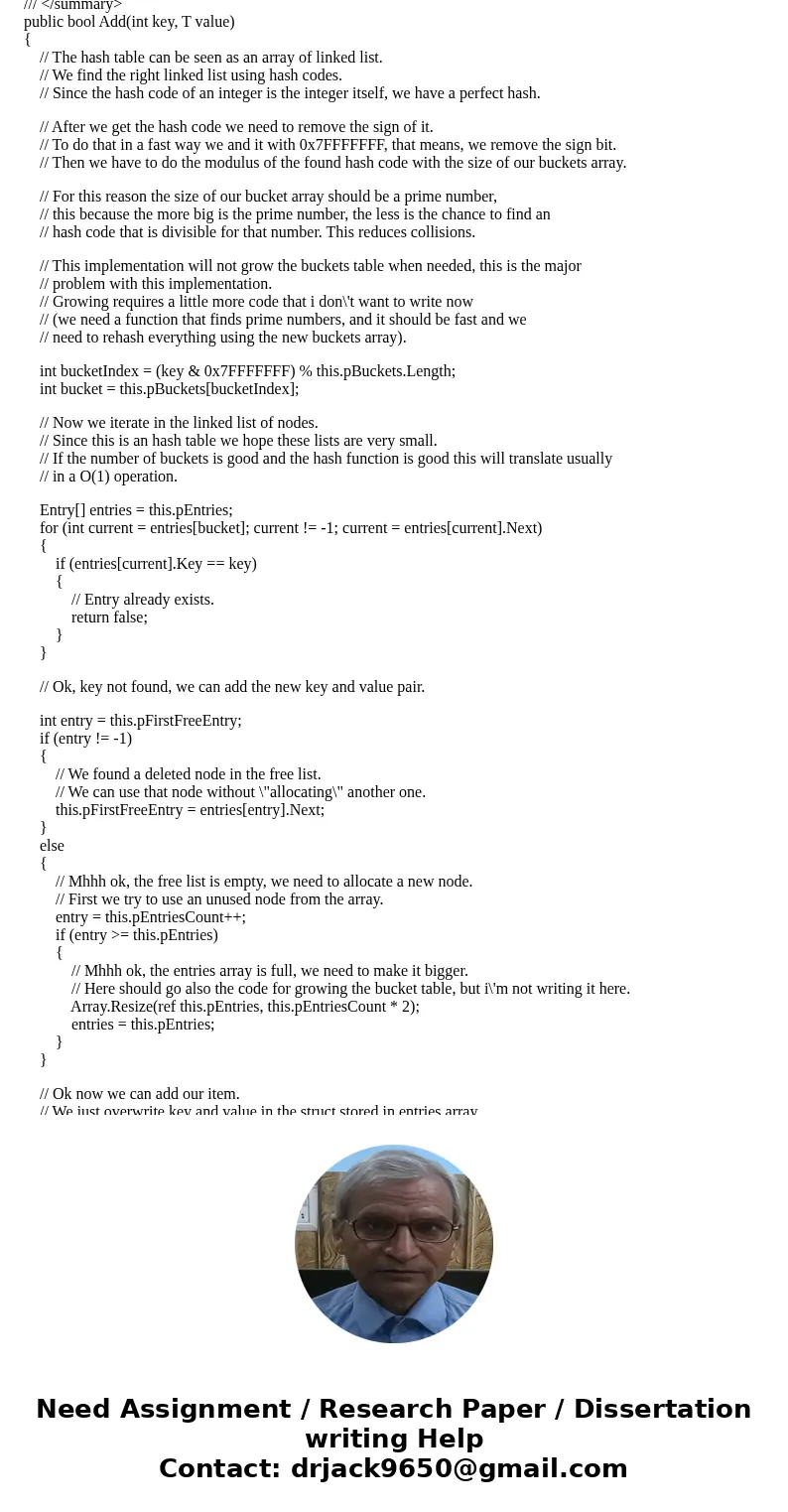
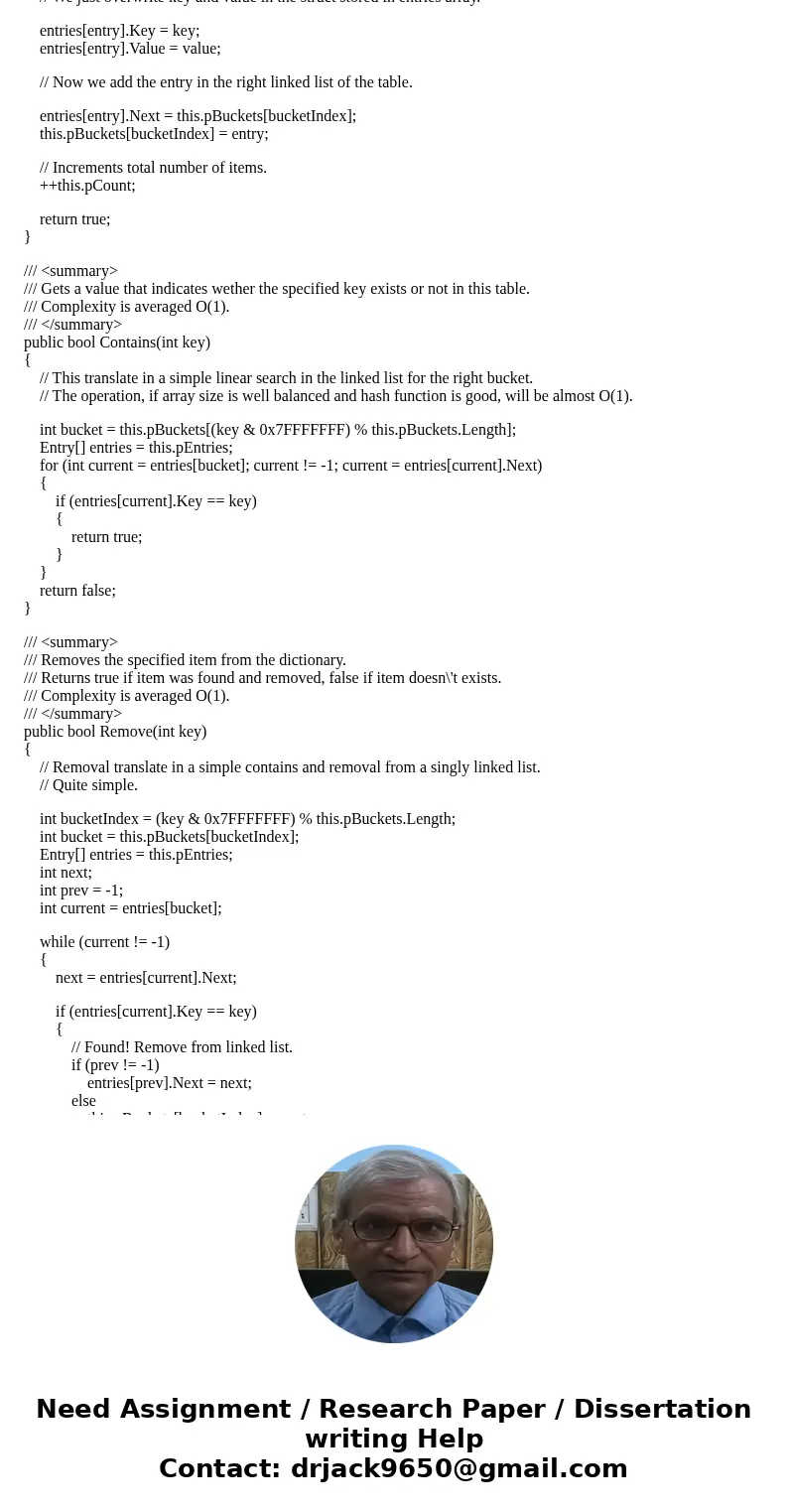
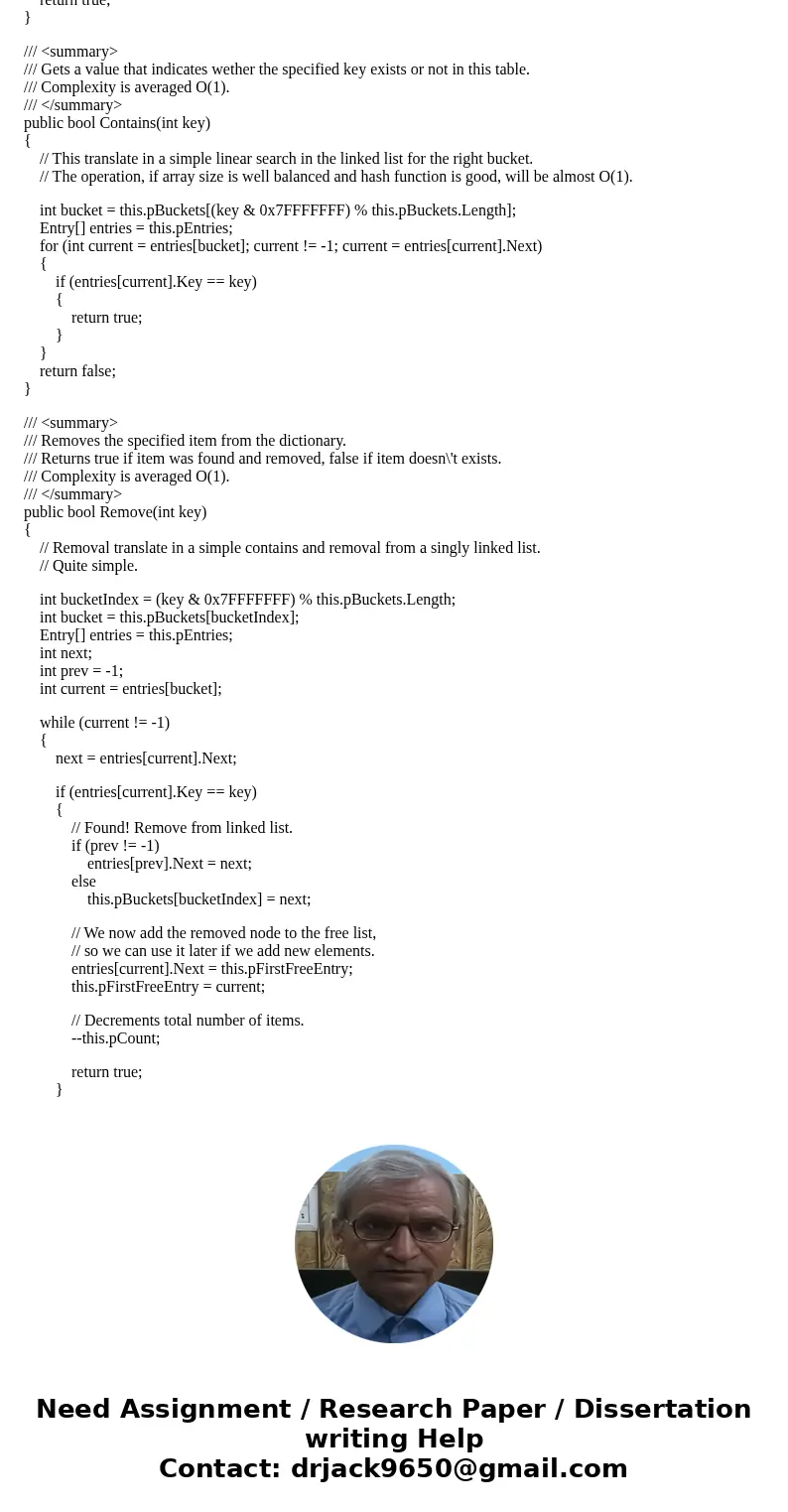
 Homework Sourse
Homework Sourse